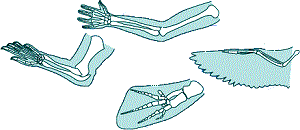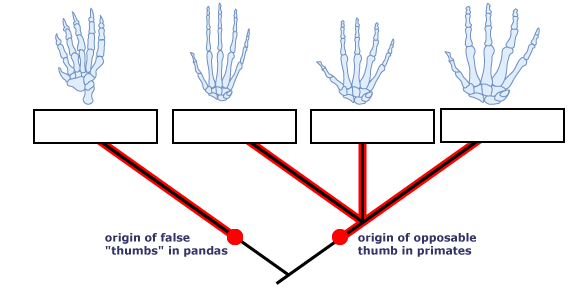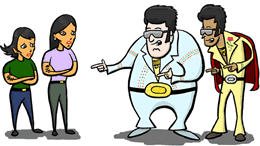Understanding Evolution: Homology and Analogy
Go to "Similarities and differences: Understanding homology and analogy"
1. Introduction to Similarities and Differences
a) In the image, which pair represents an analogy and which a homology?
b) Define homology:
c) Define analogy:
2. What is a tetrapod?
3. What are the six bones found in all tetrapod legs?
4. Identify these limbs, to what animal do they belong?

5. What did the common ancestor of all modern tetrapods look like?
6. Side Trip: "not just anatomy." - How are a bird and a crocodile homologous?
7. Similar structures that evolved independently are called ____________________.
8. a) What is the difference between a marsupial and a placental?
b) What is Smilodon?
c) What is Thylacosmilus?
9. Describe how two unrelated flowers could evolve to have a similar appearance?
10. Are similarities between sharks and dophins homologous or analogous?
11. What is morphology?
12. What three criteria are used to determine whether something is a homology or analogy?
13. Fill in the blanks of the primate tree.

14. Considering all of the evidence, are the "wings" (actually flaps of skin stretched between the legs) of sugar gliders and flying squirrels homologous or analogous structures? Explain why you would conclude this.
15. Sidetrip: See more examples of homology and examples of analogy.
a) How are a venus fly trap and a pitcher plant homologous?
b) What is unique about bowerbirds?
c) What does the Pax - 6 gene do?
d) What plant gave rise to cauliflower and broccoli?
e) The bones of the ears in mammals are homologous to what in lizards?
Resources on Evolution
Explorations Through Time – explore Berkeley website on evolution, answer questions about geologic time
Understanding Evolution – The Arthropod Story – Berkeley interactive activity with questions
Great Transitions: The Origin of Tetrapods – video worksheet to go with HHMI program
Stickleback Fish – This HHMI virtual lab requires students to count the phenotypes of stickleback fish in two distinct lakes
